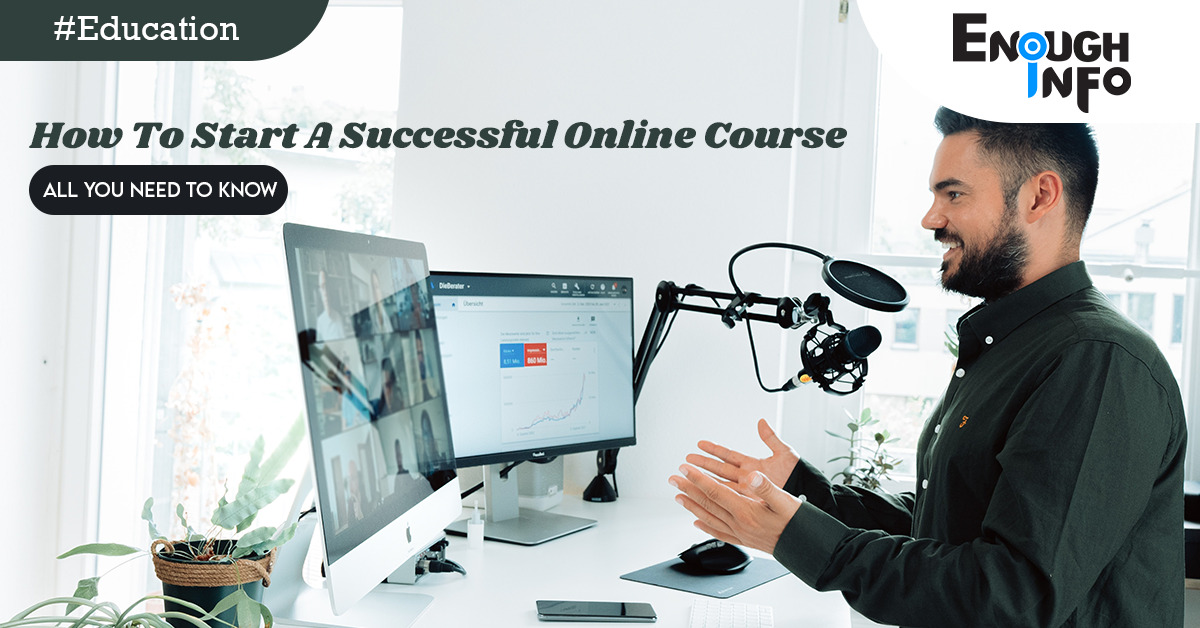
How To Start A Successful Online Course: In today’s digital age, online learning has gained tremendous popularity, opening up opportunities for individuals to share their knowledge and expertise through online courses. Starting an online course requires leveraging technology and digital tools. It enables you to explore innovative teaching methods, multimedia content, interactive elements, and data analytics to enhance the learning experience. EnoughInfo.com

Read Also: How To Start An Online Business: 11 Steps To Help You Get Started
Starting a successful online course is important because it allows you to share knowledge, empower learners, generate income, build authority, leverage technology, and make a positive impact on the lives of others. It provides a flexible and scalable platform to deliver educational content and opens doors to new opportunities for personal and professional growth. Embracing the journey of creating and launching an online course can be a rewarding and fulfilling experience. How To Crate Train A Puppy(The Ultimate Guide)
FAQs & Answers
1. Do I need to be an expert in a particular field to start an online course?
While having expertise in a specific field certainly helps, it is not always a prerequisite for starting an online course. If you have a passion for a subject and are willing to put in the necessary research and preparation, you can create a successful online course. However, it’s important to ensure that you have a solid understanding of the topic and can provide valuable knowledge and insights to your students.
2. How long should my online course be?
The duration of your online course depends on various factors, such as the complexity of the subject matter, the depth of the content, and the learning objectives. Courses can range from a few hours to several weeks or months. It’s important to strike a balance between providing enough content to cover the topic adequately and keeping the course manageable for learners. Consider breaking the content into modules or lessons that are easily digestible and structured in a logical sequence.
3. What technology and equipment do I need to create an online course?
The technology and equipment you need to create an online course will vary based on your content and delivery method. At a minimum, you will need a computer or laptop with reliable internet access, a microphone for recording audio, and a webcam if you plan to include video content. You may also need screen recording software, video editing tools, and a learning management system (LMS) or online course platform to host and deliver your course.
Read Also: How To Start A Successful Podcast
4. How do I price my online course?
Pricing your online course depends on its value, demand for similar courses, target audience affordability, and the competitive environment. Market research will show you how much similar courses cost and what makes yours different. To suit students’ finances and provide value, offer tiered pricing, payment plans, or bonuses. Based on feedback, market demand, and course value, change pricing. How To Make Homemade Pasta(A Step-By-Step Guide)
5. How do I market my online course and attract students?
Marketing your online course involves creating a comprehensive strategy that includes various tactics. Start by identifying your target audience and understanding their needs and preferences. Develop compelling course descriptions and sales pages that clearly communicate the value and benefits of your course. Leverage social media platforms, content marketing, email marketing, and collaborations with influencers or industry partners to reach your target audience. Engage with online communities, participate in relevant forums or groups, and consider offering limited-time promotions or early bird discounts to generate interest and drive enrollment.
6. How can I ensure a positive learning experience for my students?
To ensure a positive learning experience for your students, focus on creating engaging and interactive content, fostering a sense of community, and providing prompt and supportive communication. Incorporate multimedia elements, interactive exercises, and opportunities for student collaboration. Establish discussion forums or community spaces where students can connect, ask questions, and share insights. Be responsive to student inquiries and provide timely feedback and guidance. Regularly collect feedback from students and use it to improve your course content, structure, and delivery methods.
7. How do I handle technical issues or difficulties faced by my students?
Technical issues are common in online learning, and it’s important to have a plan in place to address them. Provide clear instructions for accessing and navigating the course platform, troubleshooting common technical problems, and contacting technical support if needed. Consider creating a knowledge base or FAQ section to address frequently asked questions and common technical issues. Be responsive and empathetic when students face difficulties, and provide prompt assistance to ensure they can continue their learning without unnecessary frustration. How To Play The Banjo For Beginners
8. Should I offer a refund policy for my online course?
Offering a refund policy is a personal decision that depends on various factors such as the nature of your course, your target audience, and industry standards. While a refund policy can provide reassurance to potential students, it’s important to establish clear terms and conditions to protect your business interests. Consider offering a refund period within a specified timeframe, but also provide access to your course materials in a way that discourages abuse of the refund policy.
Read Also: 15 Effective Tips For Creating Value For Your Customers
The Path to Success: How to Start a Successful Online Course

If you have a passion for teaching and want to create a successful online course, this comprehensive guide will walk you through the essential steps to get started. From defining your course idea to marketing and delivering your content, we will explore the key elements that contribute to a thriving online course business. How To Style Short Curly Hair(The Ultimate Guide)
Understanding the Online Course Landscape:
- The Benefits of Online Learning: Explore the advantages of online learning, such as flexibility, accessibility, and the ability to reach a global audience. Understand the growth and potential of the online education market.
- Identifying Your Target Audience: Define the specific audience you want to target with your online course. Consider their needs, interests, and demographics to tailor your course content and marketing strategies effectively.
Defining Your Course Idea:
- Discovering Your Expertise and Passion: Reflect on your skills, knowledge, and passions to identify a topic that you can teach with expertise and enthusiasm. Choose a subject that aligns with your interests and resonates with your target audience.
- Identifying Marketable Topics: Research the market to identify popular and in-demand topics within your niche. Analyze competitor offerings and determine how you can differentiate your course to attract learners. How To Know If You Are Depressed( Best Guide)
- Conducting Market Research: Utilize market research techniques to validate the demand for your course idea. Gather insights on the target audience’s needs, competition, pricing, and potential marketing strategies.
Planning Your Course Curriculum:
- Setting Clear Learning Objectives: Define specific, measurable learning objectives for your course. Clearly articulate what students will achieve and learn upon completion. How To Shrink Sweat-Pants (The Ultimate Guide)
- Breaking Down the Course Content: Organize the course content into modules, lessons, or sections. Create a logical flow that guides students through the learning journey and helps them absorb the information effectively.
- Choosing the Right Format and Structure: Determine the format that best suits your course content and learning objectives. Consider options such as video lectures, written materials, quizzes, assignments, or live sessions. Structure your course to provide a balanced and engaging learning experience.
Creating Engaging Course Content:
- Selecting Effective Teaching Methods: Choose teaching methods that align with your content and resonate with your target audience. Consider a mix of instructional approaches, such as lectures, demonstrations, case studies, and interactive exercises.
- Creating Engaging Multimedia Content: Utilize multimedia elements, such as high-quality videos, graphics, and animations, to enhance the visual appeal and interactivity of your course. Balance text-based content with multimedia elements for an engaging learning experience. How To Create A DIY Home Decor On A Budget
- Incorporating Interactive Elements: Promote active learning by incorporating interactive elements, such as quizzes, assessments, discussion forums, and collaborative projects. Encourage student engagement and participation throughout the course.
Choosing the Right Online Course Platform:
- Evaluating Platform Features and Functionality: Research and compare different online course platforms to find one that aligns with your needs. Consider features like course management, student analytics, marketing tools, and integration capabilities.
- Considering Pricing and Revenue Models: Evaluate the pricing structure and revenue models offered by the platforms. Choose a model that aligns with your pricing strategy and allows you to monetize your course effectively. 30 Hobbies That Make You Money
- Assessing Technical Support and Integration: Consider the technical support provided by the platform and its compatibility with your existing systems. Ensure the platform offers a seamless user experience for both instructors and students.
Read Also: How To Be A Better Decision Maker (10 Good Tips)
Building Your Online Course Website:
- Selecting a Domain Name and Hosting Provider: Choose a domain name that reflects your brand and is easy to remember. Select a reliable hosting provider to ensure the stability and security of your website.
- Designing a User-Friendly Website: Create a visually appealing and user-friendly website that showcases your course and facilitates easy navigation. Incorporate intuitive menus, clear course descriptions, and a visually pleasing layout.
- Integrating Payment Gateways and Enrollment Systems: Integrate secure payment gateways to process course enrollments and transactions. Automate the enrollment process to provide a seamless experience for your learners.
Marketing Your Online Course:
- Defining Your Marketing Strategy: Develop a comprehensive marketing strategy that includes a mix of online and offline promotional activities. Identify your unique selling points and craft compelling messages to attract your target audience.
- Creating Compelling Course Descriptions and Sales Pages: Write persuasive course descriptions and sales pages that highlight the value and benefits of your course. Use persuasive language, testimonials, and visuals to captivate potential learners.
- Leveraging Social Media and Content Marketing: Utilize social media platforms to promote your course and engage with your target audience. Create valuable content related to your course topic, such as blog posts, videos, and infographics, to establish yourself as an expert and attract potential learners. How To Play The Trumpet For Beginners
- Implementing Email Marketing Campaigns: Build an email list of interested prospects and communicate with them regularly through email marketing campaigns. Provide valuable content, updates, and exclusive offers to nurture their interest and convert them into paying customers. 30 Ways To Make Money Online And Offline
Engaging with Your Students:
- Establishing a Sense of Community: Create a supportive and interactive learning environment by fostering a sense of community among your students. Encourage discussions, peer-to-peer interaction, and collaboration to enhance the learning experience.
- Providing Prompt and Supportive Communication: Be responsive to student inquiries and provide timely support. Engage with your students through discussion forums, live Q&A sessions, or email to address their questions and concerns.
- Encouraging Student Interaction and Collaboration: Design activities and assignments that promote student interaction and collaboration. Encourage students to share their insights, engage in group projects, or participate in online forums to enhance their learning experience. How To Organize A Garage(The Best Guide)

Pricing Your Online Course:
- Evaluating Pricing Strategies: Determine the optimal pricing strategy for your course, considering factors such as the course’s value, your target audience’s affordability, and the competitive landscape. Consider options like one-time payments, installment plans, or subscription-based models.
- Determining the Value of Your Course: Assess the value your course provides to learners based on its content, outcomes, and potential career or personal benefits. Communicate this value effectively to justify your pricing and attract students who recognize the worth of your course.
- Offering Pricing Options and Incentives: Consider offering different pricing options, such as tiered pricing or bundled packages, to cater to different customer segments. Additionally, provide incentives like early bird discounts, limited-time promotions, or bonuses to encourage enrollment and create a sense of urgency.
Read Also: How to Create an Effective Content Marketing Plan (2023)
Delivering and Updating Your Course:
- Planning Course Launch and Enrollment Periods: Strategically plan the launch and enrollment periods for your course to create excitement and urgency among potential learners. Consider offering limited enrollment periods or exclusive bonuses to incentivize early sign-ups. How To Make A Vegan Dinner
- Creating a Structured Learning Experience: Deliver your course in a structured manner, providing a clear roadmap and pacing for students to follow. Release course modules or lessons at regular intervals to maintain engagement and facilitate a progressive learning experience.
- Collecting Feedback and Improving Your Course: Regularly collect feedback from your students to evaluate their learning experience and identify areas for improvement. Use this feedback to make necessary updates to your course content, structure, or delivery methods, ensuring a high-quality learning experience.
Ensuring Course Quality and Continuous Improvement:
- Quality Assurance and Course Evaluation: Regularly assess the quality of your course content, including the accuracy, relevance, and clarity of the information. Conduct course evaluations, solicit feedback from students, and make necessary revisions to maintain a high standard of quality. 22 Top Foods For Promoting Heart Health(All You Need to Know)
- Seeking Student Feedback and Testimonials: Encourage students to provide feedback and testimonials about their learning experience. Positive testimonials and reviews can serve as social proof, building trust and attracting new learners to your course.
- Staying Updated with Industry Trends: Stay informed about the latest trends, developments, and advancements in your field of expertise. Continuously update your course content to reflect new information, emerging best practices, or changes in industry standards.
Scaling Your Online Course Business:
- Automating Processes and Systems: As your online course business grows, automate repetitive tasks and processes, such as enrollment, payment processing, and course delivery. Use learning management systems and automation tools to streamline operations and scale efficiently. https://enoughinfo.com/how-to-start-a-s…ul-online-course
- Collaborating with Other Instructors or Experts: Consider collaborating with other instructors or industry experts to expand your course offerings or provide complementary content. Joint ventures or partnerships can enhance the value of your course and attract a wider audience. https://enoughinfo.com/how-to-start-a-s…ul-online-course
- Expanding Your Course Offerings: Diversify your course offerings by creating additional courses or advanced modules that cater to different skill levels or specialized topics. This allows you to serve a broader range of learners and increase revenue streams.
Conclusion:
Empowering Learners and Creating Success: In conclusion, starting a successful online course requires careful planning, strategic marketing, engaging content, and ongoing commitment to quality. By defining your course idea, creating valuable content, engaging with your students, and continuously improving your course, you can empower learners, achieve business success, and make a lasting impact in the online education landscape. Embrace the journey of creating and delivering your online course, and watch as your knowledge and expertise inspire and transform the lives of your students.
Recommended;
How to Grow YouTube Subscriptions (8 Strategies in 2023)




